The other battle of Brunete: an untold Spanish Civil War massacre
Archeologists reconstruct an obscure episode in which 500 Republican soldiers were picked off by machine-gun fire

Eighty years ago, the only thing that existed on the plains of Brunete was gunfire, explosions and death. On January 13, 1939, when Spanish dictator Francisco Franco had all but won the war, 500 Republican soldiers were killed by a barrage of shells from a Francoist battalion that was itself protected by a concrete T-shaped fort in Olivar de Veliso, near today’s M-600 road connecting Brunete with El Escorial, in the Madrid region.
This seldom mentioned offensive – one of the last of the Civil War – was launched by the Republican army in a final bid for victory. Colonel Segismundo Casado, the man in charge of targeting the 20th Francoist division, ordered his troops to advance out of the trenches after an initial artillery attack. His soldiers were out in the open and relied on eight tanks for protection. These armored vehicles, however, became lost in fog, leaving the infantry exposed.
Archeology’s potential lies in its recreation of the details of history
Alfredo González-Ruibal
Seven of the eight tanks were shelled by an anti-tank cannon on the Francoist side, where artillery corporal Elicio Correa Correa “was able to destroy five ‘red’ tanks out of the huge number used by the enemy, thanks to his rapid and accurate fire,” states the Official State Bulletin, which also mentions that Correa was decorated for his actions.
By all accounts, the Republican advance was short-lived. “Almost 300 Republicans must have fallen in the space of an hour. The battle was like those of World War I,” says Spanish National Research Council (CSIC) archeologist Alfredo González-Ruibal, who has been digging around the Francoist fort and bunkers, which are still standing. This legacy from the war will form part of the Fortifications Project, an initiative subsidized by the Madrid regional government with support from the city of Brunete, where a Center for Understanding the Civil War will open in the next few months.
They wouldn’t have had a chance even on a sunny day
Alfredo González-Ruibal
“They were exposed at all times on this plain,” says González-Ruibal. “When they abandoned the dry riverbed, they became an easy target. They wouldn’t have had a chance even on a sunny day. A huge amount of ammunition from the Franco forces has turned up, but very little from the Republicans.” This expert described the battle as “as useless as they come.”
It appears that the Francoists were aware of the enemies’ plans, probably through a leak in Casado’s inner circle, and they had sent for reinforcements in the shape of three extra battalions plus extra machine guns and mortars.
Research in 3D
González-Ruibal’s team used drones and LiDAR surveying technology to trace the two armies’ steps. “We can see what they saw,” he says.
Out in the open, the Republicans would only have been able to lie down and pray the gunfire didn’t get them. If they crouched into a position to fire themselves, they would have been picked off immediately. This explains why González-Ruibal’s team has found no shells close to the Francoist fort, which has been described as “an indestructible work of engineering.”
Neither the looters of the post-war era nor urban speculators who have been putting up second homes in the area have been able to make much of an impression on it. Along with the bunkers, it stands as an unimpaired witness to the events of that fateful January day while other evidence is being collected.
“Some of the locals have been coming to us with the remains of shells they have come across while building their houses,” says González-Ruibal.
But there are no signs of the bodies of the 500 Republicans who died in the battle and who are probably, according to González-Ruibal, lying in an unmarked mass grave somewhere.
Soldiers of Jesus Christ
“Archeology’s potential lies in its recreation of the details of history,” says archeologist Alfredo González-Ruibal, referring to the discovery of a religious silver medal in Brunete. “It should not be reduced to mere documentation or the classification of remains.”
On one side of the medal is the face of Jesus Christ blessing a group of soldiers and on the other, two soldiers in front of a statue of the Virgin Mary with Jesus and two angels. The image is accompanied by the words of Saint Paul: "Endure hardness, as a good soldier of Jesus Christ." And on the other side: "You are to imitate me, as I imitate Christ."
English version by Heather Galloway.
Tu suscripción se está usando en otro dispositivo
¿Quieres añadir otro usuario a tu suscripción?
Si continúas leyendo en este dispositivo, no se podrá leer en el otro.
FlechaTu suscripción se está usando en otro dispositivo y solo puedes acceder a EL PAÍS desde un dispositivo a la vez.
Si quieres compartir tu cuenta, cambia tu suscripción a la modalidad Premium, así podrás añadir otro usuario. Cada uno accederá con su propia cuenta de email, lo que os permitirá personalizar vuestra experiencia en EL PAÍS.
¿Tienes una suscripción de empresa? Accede aquí para contratar más cuentas.
En el caso de no saber quién está usando tu cuenta, te recomendamos cambiar tu contraseña aquí.
Si decides continuar compartiendo tu cuenta, este mensaje se mostrará en tu dispositivo y en el de la otra persona que está usando tu cuenta de forma indefinida, afectando a tu experiencia de lectura. Puedes consultar aquí los términos y condiciones de la suscripción digital.
More information
Archived In
Últimas noticias
Pinochet’s victims grapple with José Antonio Kast’s rise in Chile
Reinhard Genzel, Nobel laureate in physics: ‘One-minute videos will never give you the truth’
How Japan is trying to avert ‘digital defeat’
The complicated life of Francesca Albanese: A rising figure in Italy but barred from every bank by Trump’s sanctions
Most viewed
- Pablo Escobar’s hippos: A serious environmental problem, 40 years on
- Why we lost the habit of sleeping in two segments and how that changed our sense of time
- Charles Dubouloz, mountaineering star, retires at 36 with a farewell tour inspired by Walter Bonatti
- Trump’s obsession with putting his name on everything is unprecedented in the United States
- The Florida Keys tourist paradise is besieged by immigration agents: ‘We’ve never seen anything like this’










































